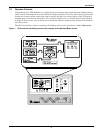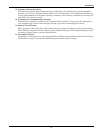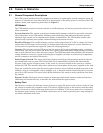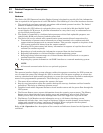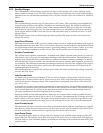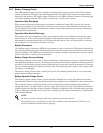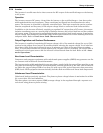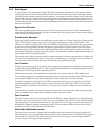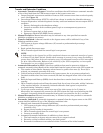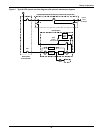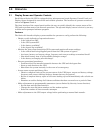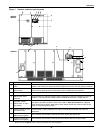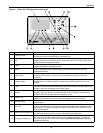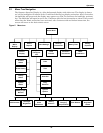
Theory of Operation
13
2.2.4 Inverter
The inverter is a solid state device that converts the DC output of the rectifier/charger or the battery
to AC power.
Operation
The inverter converts DC power—from either the battery or the rectifier/charger—into three pulse-
width-modulated/six-step waveforms. These waveforms are filtered into low-distortion sine wave
power. The inverter is controlled by digitally controlled logic. This logic controls the precise synchro-
nization, amplitude and frequency of the output voltage based on connected load characteristics.
In addition to the inverter efficiently supplying a regulated AC output from a DC source, the output
isolation transformer acts as a second stage of isolation between the critical load bus and the commer-
cial source power. The inverter is configured to handle most critical load inrush surges. It maintains
output voltage Total Harmonic Distortion (THD) within specifications even when handling non-linear
computer loads. Refer to Non-Linear Load Characteristics.
Output Regulation and Overload Performance
The inverter is capable of sustaining full output voltage (±2% of the nominal voltage) for up to 150%
overload at the output for as long as 30 seconds without reducing the output voltage. It can also han-
dle at least 125% of the rated current for up to 10 minutes and 104% of the rated current continu-
ously. If an overload exceeds the system capacity and a bypass source is available, the critical load is
transferred to the bypass source and the inverter is disconnected from the load. Refer to 3.5 - Auto-
matic Operations.
Non-Linear Load Characteristics
Computers and computer equipment with switch-mode power supplies (SMPS) may generate non-lin-
ear currents rich in fifth and seventh harmonics.
The inverter pulse-width-modulated/six-step waveform, coupled with the output filter, provides a nat-
ural path for reducing the fifth and seventh harmonic currents produced by the load. The inverter/fil-
ter limits the output voltage THD to less than 5% with up to 100% typical electronic data processing
(EDP) loads. EDP equipment characteristically includes both non-linear and linear load components.
Unbalanced Load Characteristics
Unbalanced loads are actively regulated. The phase-to-phase voltage balance is maintained to within
2%, even with a 50% load imbalance.
The three-phase, root mean square (RMS) average voltage is also regulated through a separate con-
trol circuit using phase-to-phase sensing.




